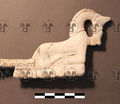IT-4 unidentifiable: Difference between revisions
No edit summary |
No edit summary |
||
| (One intermediate revision by one other user not shown) | |||
| Line 12: | Line 12: | ||
|field_name=Pirchboden | |field_name=Pirchboden | ||
|find_context=house 2 | |find_context=house 2 | ||
|coordinate_n=47.310719 | |||
|coordinate_e=11.590627 | |||
|date_find=between 1993 and 2000 | |date_find=between 1993 and 2000 | ||
|location=Museum Wattens | |location=Museum Wattens | ||
| Line 21: | Line 23: | ||
}} | }} | ||
== Commentary == | == Commentary == | ||
The fragmented, but large and elaborately carved piece of antler was found in the cellar of a house in the settlement on the Pirchboden near Fritzens (North Tyrol). The house is assumed to have been destroyed in the course of the Roman Alpine campaign in 15 BC, but the object is likely to be rather older than that. With a length of 31.5 cm, it is skilfully carved out of a single unusually large piece of a red deer's antler (''cervus elaphus''; not an elk's, as ascertained by {{bib|Tomedi 2001}}: 31 in consultation with a palaeozoologist). Curved in a slight S-shape, it is partly decorated with radial-eye pattern and ends in the idealised shape of a horse. In the centre it is pierced by a thick iron peg; protruding on the same side as the peg are the remains of seven smaller bronze pegs. {{bib|Tomedi 2001}}: 31 (see also {{bib|Tomedi 2004}}: 384) suggested that the piece is part of a musical instrument, for example an angle harp. Also possible is a | The fragmented, but large and elaborately carved piece of antler was found in the cellar of a house in the settlement on the Pirchboden near Fritzens (North Tyrol). The house is assumed to have been destroyed in the course of the Roman Alpine campaign in 15 BC, but the object is likely to be rather older than that. With a length of 31.5 cm, it is skilfully carved out of a single unusually large piece of a red deer's antler (''cervus elaphus''; not an elk's, as ascertained by {{bib|Tomedi 2001}}: 31 in consultation with a palaeozoologist). Curved in a slight S-shape, it is partly decorated with radial-eye pattern and ends in the idealised shape of a horse. In the centre it is pierced by a thick iron peg; protruding on the same side as the peg are the remains of seven smaller bronze pegs. {{bib|Tomedi 2001}}: 31 (see also {{bib|Tomedi 2004}}: 384) suggested that the piece is part of a musical instrument, for example an angle harp. Also possible is a Scythian lyre. However, attempts at reconstructing such an instrument by a specialist for historical instruments have not yielded any elucidating results. Today, the object is restored from the available parts (without reconstruction of missing fragments). | ||
{{bibliography}} | {{bibliography}} | ||
Latest revision as of 18:04, 3 April 2020
| Object | |
|---|---|
| Classification: | musical instrument |
| Archaeological type: | probably angle harp or lyre |
| Material: | antler |
| Size: | length: 31.5 cm, width: 1.6 cm, height: 7.2 cm |
| Condition: | damaged, incomplete, restored |
| Date: | 120–15 BC |
| Date derived from: | archaeological context |
|
| |
| Site: | Fritzens (Tirol, Austria) |
| Field name: | Pirchboden |
| Archaeological context: | house 2 |
| Coordinates (approx.): | 47° 18' 38.59" N, 11° 35' 26.26" E |
| Find date: | between 1993 and 2000 |
| Current location: | Museum Wattens (repository) |
| Inventory Nr.: | none |
|
| |
| Inscription: | IT-4 (piθiẹ[???]ịχụṛṿịle) |
|
| |
| Sources: | Tomedi 2001: 31–32, fig. 19 Tomedi 2004: 384 et seq., fig. 2 |
Images
|
Object IT-4 unidentifiable with inscription IT-4.
|
Object IT-4 unidentifiable - sideview.
|
Object IT-4 unidentifiable - upper side.
|
Object IT-4 unidentifiable - sideview.
|
Object IT-4 unidentifiable - detail.
|
|
Object IT-4 unidentifiable with inscription IT-4 - underside.
|
Object IT-4 unidentifiable with inscription IT-4 - detail underside.
|
Commentary
The fragmented, but large and elaborately carved piece of antler was found in the cellar of a house in the settlement on the Pirchboden near Fritzens (North Tyrol). The house is assumed to have been destroyed in the course of the Roman Alpine campaign in 15 BC, but the object is likely to be rather older than that. With a length of 31.5 cm, it is skilfully carved out of a single unusually large piece of a red deer's antler (cervus elaphus; not an elk's, as ascertained by Tomedi 2001: 31 in consultation with a palaeozoologist). Curved in a slight S-shape, it is partly decorated with radial-eye pattern and ends in the idealised shape of a horse. In the centre it is pierced by a thick iron peg; protruding on the same side as the peg are the remains of seven smaller bronze pegs. Tomedi 2001: 31 (see also Tomedi 2004: 384) suggested that the piece is part of a musical instrument, for example an angle harp. Also possible is a Scythian lyre. However, attempts at reconstructing such an instrument by a specialist for historical instruments have not yielded any elucidating results. Today, the object is restored from the available parts (without reconstruction of missing fragments).



